- Books Name
- CBSE Class 7 Social Science Book
- Publication
- Param Publication
- Course
- CBSE Class 7
- Subject
- Social Science
* Introduction
The chapter deals with establishment expansion consolidation and downfall of Delhi Sultanate. The policies and programmes of sultans are described with its impacts. The chapter also explains the achievements of sultan of Delhi.
* Historic back ground
Delhi first became the capital of a kingdom under the Tomara Rajputs, who were defeated in the middle of the twelfth century by the Chauhans (also referred to as Chahamanas) of Ajmer. It was under the Tomaras and Chauhans that Delhi became an important commercial centre.
Many rich Jaina merchants lived in the city and constructed several temples. Coins minted here, called Dehliwal, had a wide circulation.
The transformation of Delhi into a capital that controlled vast areas of the subcontinent started with the foundation of the Delhi Sultanate in the beginning of the thirteenth century.
The Delhi Sultans built many cities in the area that we now know as Delhi.
* The rulers of Delhi
(A) RAJPUT DYNASTIES
Tomaras Early twelfth century - 1165
Ananga Pala 1130 -1145
Chauhans 1165 -1192
Prithviraj Chauhan 1175 -1192
(B) EARLY TURKISH RULERS 1206-1290
Qutbuddin Aybak 1206 -1210
Shamsuddin Iltutmish 1210 -1236
Raziyya 1236 -1240
Ghiyasuddin Balban 1266 -1287
(C) KHALJI DYNASTY 1290 - 1320
Jalaluddin Khalji 1290 - 1296
Alauddin Khalji 1296 -1316
(D) TUGHLUQ DYNASTY 1320 - 1414
Ghiyasuddin Tughluq 1320 -1324
Muhammad Tughluq 1324 -1351
Firuz Shah Tughluq 1351 -1388
(E) SAYYID DYNASTY 1414 - 1451
Khizr Khan 1414 -1421
(F) LODI DYNASTY 1451 - 1526
Bahlul Lodi 1451 -1489
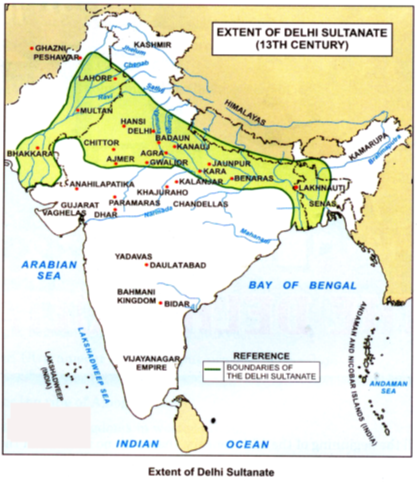
* Finding out about the Delhi Sultans
(i) Although inscriptions, coins and architecture provide a lot of information, especially valuable are “histories”, tarikh (singular) / tawarikh (plural), written in Persian, the language of administration under the Delhi Sultans.
(ii) The authors of tawarikh were learned men: secretaries, administrators, poets and courtiers, who both recounted events and advised rulers on governance, emphasising the importance of just rule.
(iii) Keep the following additional details in mind: (1) the authors of tawarikh lived in cities (mainly Delhi) and hardly ever in villages. (2) They often wrote their histories for Sultans in the hope of rich rewards.
(3) These authors advised rulers on the need to preserve an “ideal” social order based on (i) birthright and (ii) gender distinctions. Their ideas were not shared by everybody.
(iv) In 1236 Sultan Iltutmish’s daughter, Raziyya, became Sultan. The chronicler of the age, Minhaj-i Siraj, recognised that she was more able and qualified than all her brothers. But he was not comfortable at having a queen as ruler. Nor were the nobles happy at her attempts to rule independently. She was removed from the throne in 1240.
(v) What Minhaj-i Siraj thought about Raziyya that the queen’s rule went against the ideal social order created by God, in which women were supposed to be subordinate to men. He therefore asked: “In the register of God’s creation, since her account did not fall under the column of men, how did she gain from all of her excellent qualities?”
On her inscriptions and coins Raziyya mentioned that she was the daughter of Sultan Iltutmish. This was in contrast to the queen Rudramadevi (1262-1289), of the Kakatiya dynasty of Warangal, part of modern Andhra Pradesh. Rudramadevi changed her name on her inscriptions and pretended she was a man. Another queen, Didda, ruled in Kashmir (980-1003). Her title is interesting: it comes from “didi” or “elder sister”, an obviously affectionate term given to a loved ruler by her subjects.
* From garrison town to empire
The expansion of the Delhi Sultanate
(i) In the early thirteenth century the control of the Delhi Sultans rarely went beyond heavily fortified towns occupied by garrisons. The Sultans seldom controlled the hinterland of the cities and were therefore dependent upon trade, tribute or plunder for supplies.
(ii) Controlling garrison towns in distant Bengal and Sindh from Delhi was extremely difficult. Rebellion, war, even bad weather could snap fragile communication routes. The state was also challenged by Mongol invasions from Afghanistan and by governors who rebelled at any sign of the Sultan’s weakness. The Sultanate barely survived these challenges. Its expansion occurred during the reigns of Ghiyasuddin Balban, Alauddin Khalji and Muhammad Tughluq.
(iii) The first set of campaigns along the “internal frontier” of the Sultanate aimed at consolidating the hinterlands of the garrison towns. During these campaigns forests were cleared in the Ganga-Yamuna doab and hunter gatherers and pastoralists expelled from their habitat. These lands were given to peasants and agriculture was encouraged. New fortresses and towns were established to protect trade routes and to promote regional trade.
(iv) The second expansion occurred along the “external frontier” of the Sultanate. Military expeditions into southern India started during the reign of Alauddin Khalji and culminated with Muhammad Tughluq. In their campaigns, Sultanate armies captured elephants, horses and slaves and carried away precious metals.
(v) By the end of Muhammad Tughluq’s reign, 150 years after somewhat humble beginnings, the armies of the Delhi Sultanate had marched across a large part of the subcontinent. They had defeated rival armies and seized cities. The Sultanate collected taxes from the peasantry and dispensed justice in its realm.
* The Masjid
(i) A mosque is called a masjid in Arabic, literally a place where a Muslim prostrates in reverence to Allah. In a “congregational mosque” (masjid-i jami or jama masjid) Muslims read their prayers (namaz) together.
(ii) Members of the congregation choose the most respected, learned male as their leader (imam) for the rituals of prayer. He also delivers the sermon (khutba) during the Friday prayer.
(iii) During prayer, Muslims stand facing Mecca. In India this is to the west. This is called the qibla.
(iv) The Delhi Sultans built several mosques in cities all over the subcontinent. These demonstrated their claims to be protectors of Islam and Muslims. Mosques also helped to create the sense of a community of believers who shared a belief system and a code of conduct. It was necessary to reinforce this idea of a community because Muslims came from a variety of backgrounds.
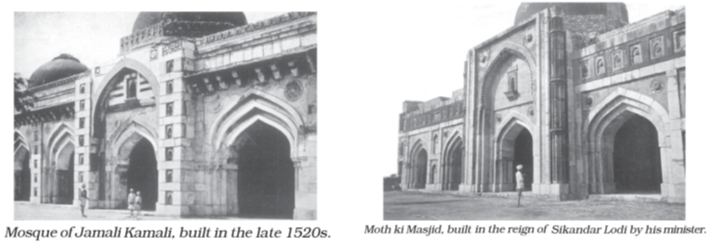
Illustration-1 : Who was the last Hindu ruler before the sultanate rule?
Solution : Prithviraj Chauhan
Illustration-2 : Who established slave dynasty in 1206?
Solution : Qutab-ud-din Aibak
Illustration-3 : Which sultanate rulers policies provoked Hindus to revolt against them ?
Solution : Muhmmad-bin-Tughluq
Illustration-4 : Who sacked Delhi in 1398 ?
Solution : Timur Lung (Lane)
Illustration-5 : Who was the husband of Raziyya Sultan ?
Solution : Malik Altuniya
Illustration-6 : Who killed Raziyya Sultan and her husband ?
Solution : Rebels of her government.
* A closer look: Administration and Consolidation under the Khaljis and Tughluqs
(i) The consolidation of a kingdom as vast as the Delhi Sultanate needed reliable governors and administrators.
(ii) Rather than appointing aristocrats and landed chieftains as governors, the early Delhi Sultans, especially Iltutmish, favoured their special slaves purchased for military service, called bandagan in Persian.
(iii) They (slaves) were carefully trained to man some of the most important political offices in the kingdom. Since they were totally dependent upon their master, the Sultan could trust and rely upon them.
(iv) The Khaljis and Tughluqs continued to use bandagan and also raised people of humble birth, who were often their clients, to high political positions. They were appointed as generals and governors. However, this also introduced an element of political instability.
(v) Slaves and clients were loyal to their masters and patrons, but not to their heirs. New Sultans had their own servants. As a result the accession of a new monarch often saw conflict between the old and the new nobility.
(vi) The patronage of these humble people by the Delhi Sultans also shocked many elites and the authors of Persian tawarikh criticised the Delhi Sultans for appointing the “low and base-born” to high offices.
(vii) Like the earlier Sultans, the Khalji and Tughluq monarchs appointed military commanders as governors of territories of varying sizes. These lands were called iqta and their holder was called iqtadar or muqti.
• The duty of the muqtis was to lead military campaigns and maintain law and order in their iqtas. In exchange for their military services, the muqtis collected the revenues of their assignments as salary.
• They also paid their soldiers from these revenues. Control over muqtis was most effective if their office was not inheritable and if they were assigned iqtas for a short period of time before being shifted.
• These harsh conditions of service were rigorously imposed during the reigns of Alauddin Khalji and Muhammad Tughluq.
• Accountants were appointed by the state to check the amount of revenue collected by the muqtis. Care was taken that the muqti collected only the taxes prescribed by the state and that he kept the required number of soldiers.
(viii) As the Delhi Sultans brought the hinterland of the cities under their control, they forced the landed chieftains — the samanta aristocrats — and rich landlords to accept their authority.
(ix) Under Alauddin Khalji the state brought the assessment and collection of land revenue under its own control. The rights of the local chieftains to levy taxes were cancelled and they were also forced to pay taxes.
(x) The Sultan’s administrators measured the land and kept careful accounts.
(xi) Some of the old chieftains and landlords served the Sultanate as revenue collectors and assessors.
(xii) There were three types of taxes – (1) on cultivation called kharaj and amounting to about 50 per cent of the peasant’s produce, (2) on cattle and (3) on houses.
(xiii) It is important to remember that large parts of the subcontinent remained outside the control of the Delhi Sultans. It was difficult to control distant provinces like Bengal from Delhi and soon after annexing southern India, the entire region became independent. Even in the Gangetic plain there were forested areas that Sultanate forces could not penetrate.
(xiv) Local chieftains established their rule in these regions. Sometimes rulers like Alauddin Khalji and Muhammad Tughluq could force their control in these areas but only for a short duration.
(xv) The Mongols under Genghis Khan invaded Transoxiana in north-east Iran in 1219 and the Delhi Sultanate faced their on slaught soon after. Mongol attacks on the Delhi Sultanate increased during the reign of Alauddin Khalji and in the early years of Muhammad Tughluq’s rule. This forced the two rulers to mobilise a large standing army in Delhi which posed a huge administrative challenge.
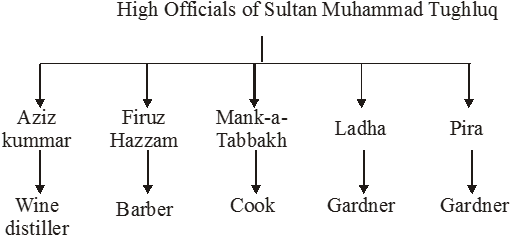
According to Giyasuddin Barni these appointments were sultan's loss of political judgement and incapacity to rule.
* Comparison between Alauddin Khalji and Muhammad Tughluq Alauddin Khalji
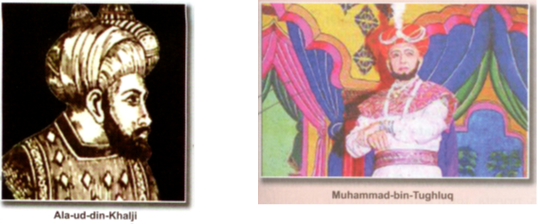
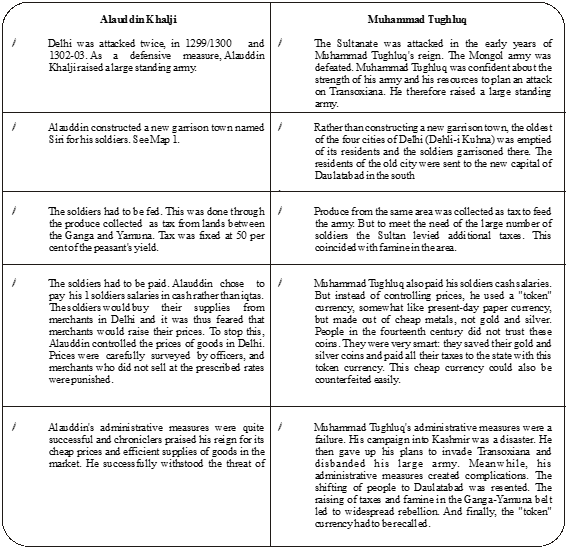
* The Sultanate in the 15th and 16th centuries
(i) After the Tughluqs, the Sayyid and Lodi dynasties ruled from Delhi and Agra until 1526.
(ii) By then, Jaunpur, Bengal, Malwa, Gujarat, Rajasthan and the entire south India had independent rulers who established flourishing states and prosperous capitals.
(iii) This was also the period which saw the emergence of new ruling groups like the Afghans and the Rajputs.
(iv) Some of the states established in this period were small but powerful and extremely well administered.
• Sher Shah Suri (1540-1555) started his career as the manager of a small territory for his uncle in Bihar and eventually challenged and defeated the Mughal emperor Humayun (1530-1540, 1555-1556).
• Sher Shah captured Delhi and established his own dynasty. Although the Suri dynasty ruled for only fifteen years (1540-1555), it introduced an administration that borrowed elements from Alauddin Khalji and made them more efficient.
• Sher Shah’s administration became the model followed by the great emperor Akbar (1556-1605) when he consolidated the Mughal Empire.
Illustration-1 : What was the basis of Sultanate laws?
Solution : Quran & Sharia
Illustration-2: Who encouraged the farmers to grow cash crops amongst the sultanate rules?
Solution: Muhammad bin Tughluq
Illustration-3: Which Tax was imposed on non muslims during sultanate rule?
Solution : Jizya or Head tax.
“Glossary”
1. Birth right: Privileges claimed on account of birth. e.g. people believed that nobles inherited their rights to govern because they were born in certain families.
2. Gender distinctions: Social and biological differences between women and men, usually, these differences are used to argue that men are superior to women.
3. Hinterland: The lands adjacent to a city or part that supply it with goods and services.
4. Garrison town: A fortified settlement with soldiers.
5. Client: Someone who is under the protection of another.

 Param Publication
Param Publication
